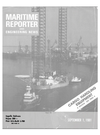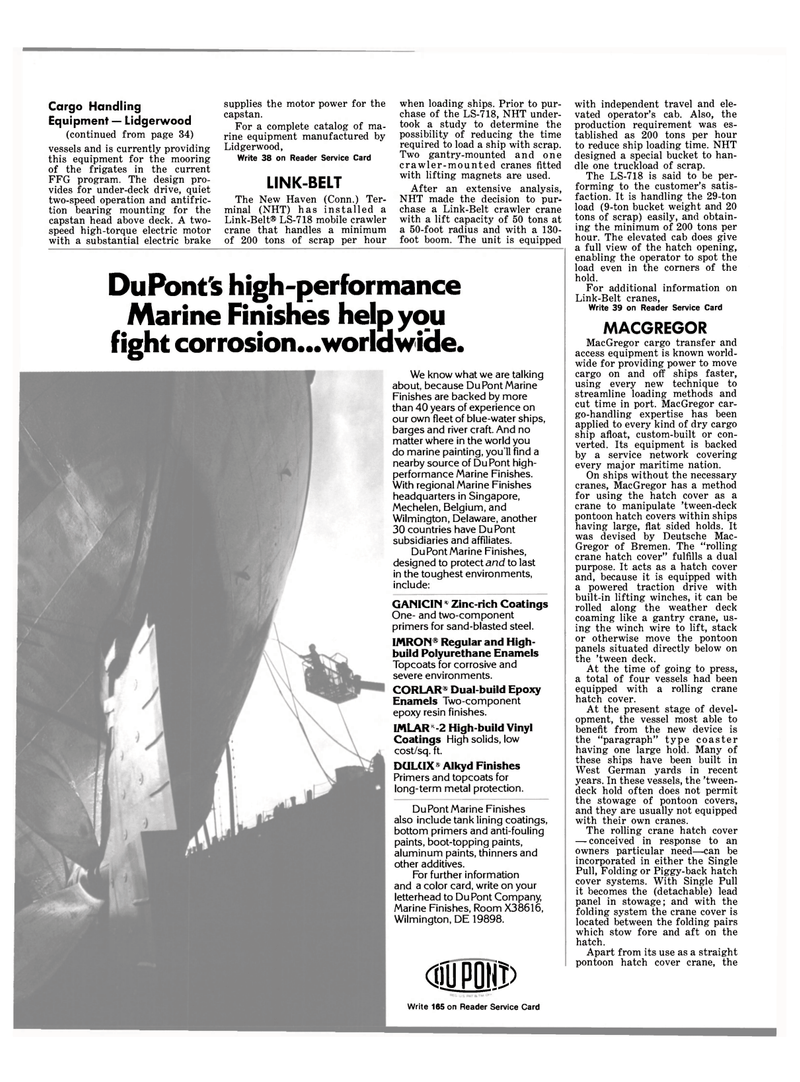
Page 34: of Maritime Reporter Magazine (September 1981)
Read this page in Pdf, Flash or Html5 edition of September 1981 Maritime Reporter Magazine
Cargo Handling
Equipment — Lidgerwood (continued from page 34) vessels and is currently providing this equipment for the mooring of the frigates in the current
FFG program. The design pro- vides for under-deck drive, quiet two-speed operation and antifric- tion bearing mounting for the capstan head above deck. A two- speed high-torque electric motor with a substantial electric brake supplies the motor power for the capstan.
For a complete catalog of ma- rine equipment manufactured by
Lidgerwood,
Write 38 on Reader Service Card
LINK-BELT
The New Haven (Conn.) Ter- minal (NHT) has installed a
Link-Belt® LS-718 mobile crawler crane that handles a minimum of 200 tons of scrap per hour when loading ships. Prior to pur- chase of the LS-718, NHT under- took a study to determine the possibility of reducing the time required to load a ship with scrap.
Two gantry-mounted and one crawler-mounted cranes fitted with lifting magnets are used.
After an extensive analysis,
NHT made the decision to pur- chase a Link-Belt crawler crane with a lift capacity of 50 tons at a 50-foot radius and with a 130- foot boom. The unit is equipped
DuPont's high-performance
Marine Finishes help you fight corrosion...worldwide.
We know what we are talking about, because Du Pont Marine
Finishes are backed by more than 40 years of experience on our own fleet of blue-water ships, barges and river craft. And no matter where in the world you do marine painting, you'll find a nearby source of DuPont high- performance Marine Finishes.
With regional Marine Finishes headquarters in Singapore,
Mechelen, Belgium, and
Wilmington, Delaware, another 30 countries have DuPont subsidiaries and affiliates.
DuPont Marine Finishes, designed to protect and to last in the toughest environments, include:
GANICINK Zinc-rich Coatings
One- and two-component primers for sand-blasted steel.
IMRON® Regular and High- build Polyurethane Enamels
Topcoats for corrosive and severe environments.
CORLAR * Dual-build Epoxy
Enamels Two-component epoxy resin finishes.
IMLAR -2 High-build Vinyl
Coatings High solids, low cost/sq. ft.
DULCIX* Alkyd Finishes
Primers and topcoats for long-term metal protection.
Du Pont Marine Finishes also include tank lining coatings, bottom primers and anti-fouling paints, boot-topping paints, aluminum paints, thinners and other additives.
For further information and a color card, write on your letterhead to DuPont Company,
Marine Finishes, Room X38616,
Wilmington, DE 19898. affllj)
Write 165 on Reader Service Card with independent travel and ele- vated operator's cab. Also, the production requirement was es- tablished as 200 tons per hour to reduce ship loading time. NHT designed a special bucket to han- dle one truckload of scrap.
The LS-718 is said to be per- forming to the customer's satis- faction. It is handling the 29-ton load (9-ton bucket weight and 20 tons of scrap) easily, and obtain- ing the minimum of 200 tons per hour. The elevated cab does give a full view of the hatch opening, enabling the operator to spot the load even in the corners of the hold.
For additional information on
Link-Belt cranes,
Write 39 on Reader Service Card
MACGREGOR
MacGregor cargo transfer and access equipment is known world- wide for providing power to move cargo on and off ships faster, using every new technique to streamline loading methods and cut time in port. MacGregor car- go-handling expertise has been applied to every kind of dry cargo ship afloat, custom-built or con- verted. Its equipment is backed by a service network covering every major maritime nation.
On ships without the necessary cranes, MacGregor has a method for using the hatch cover as a crane to manipulate 'tween-deck pontoon hatch covers within ships having large, flat sided holds. It was devised by Deutsche Mac-
Gregor of Bremen. The "rolling crane hatch cover" fulfills a dual purpose. It acts as a hatch cover and, because it is equipped with a powered traction drive with built-in lifting winches, it can be rolled along the weather deck coaming like a gantry crane, us- ing the winch wire to lift, stack or otherwise move the pontoon panels situated directly below on the 'tween deck.
At the time of going to press, a total of four vessels had been equipped with a rolling crane hatch cover.
At the present stage of devel- opment, the vessel most able to benefit from the new device is the "paragraph" type coaster having one large hold. Many of these ships have been built in
West German yards in recent years. In these vessels, the 'tween- deck hold often does not permit the stowage of pontoon covers, and they are usually not equipped with their own cranes.
The rolling crane hatch cover — conceived in response to an owners particular need—can be incorporated in either the Single
Pull, Folding or Piggy-back hatch cover systems. With Single Pull it becomes the (detachable) lead panel in stowage; and with the folding system the crane cover is located between the folding pairs which stow fore and aft on the hatch.
Apart from its use as a straight pontoon hatch cover crane, the

 33
33

 35
35
